Electric Compost Bin 2024 | Innovative Ways to Compost at Home
It’s no secret that I love composting! I try – sometimes I succeed, sometimes I fail – to covert all my friends and family to embrace composting!
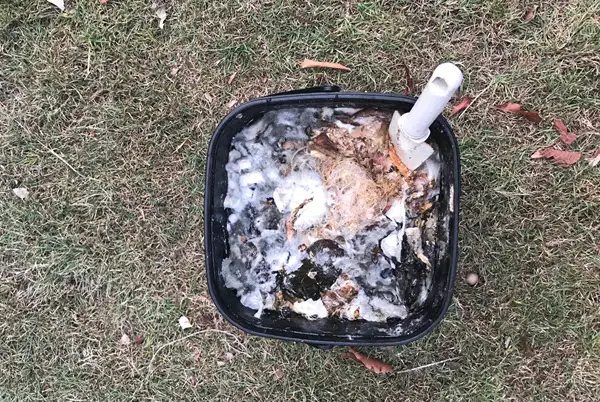
Composting is great for the environment.
Even non-gardeners – I am not a great gardener either – actively participate in composting to keep their family’s food waste out of the garbage and away from stifling landfills.
However, I know life is busy, and composting, like anything else, needs to be easy and doable! So, I keep on researching and experimenting with different methods.
Not everyone has the space or time to devote to a traditional compost heap. Fortunately, thanks to recent innovations, composting indoors isn’t just possible but is even easier than doing it outdoors.
An electric compost bin is a convenient new alternative to tossing household waste and kitchen scraps that lets you sustainably compost indoors.
The Vitamix FoodCycler, beyondGREEN Organic Waste Composter, and Lomi Countertop Composter are the leading models currently available to consumers. Each indoor composting machine comes with its own pros and cons, offering something for almost any household to jump onto the composting bandwagon!
What is an Electric Compost Bin?
An electric compost bin, also called a food recycler by many, is a unique system that breaks down kitchen scraps in a matter of days rather than weeks or months.
One of the biggest boons of electric compost bins is that they are designed to be used indoors rather than in the backyard. The majority of electric composters currently available are small enough to fit on a kitchen countertop.
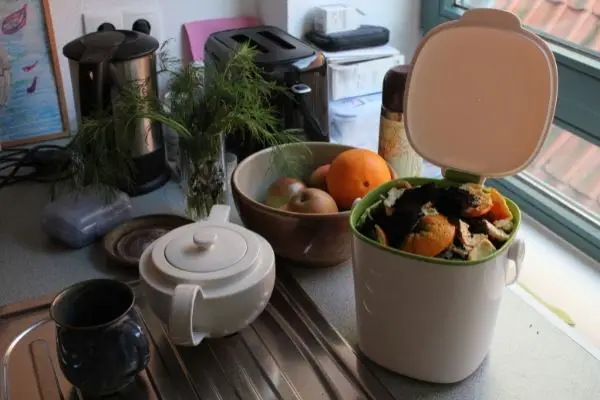
Despite the name, it’s important to note that not all electric compost bins produce traditional compost. For some models, the end result is a dry, lightweight, and sterile medium. Not the heavy, moist, and microbe-hosting compost we’re all used to.
How Do Electric Composters Work?
Each model of electric compost bin may operate slightly differently. But there are several stages electric composters may utilize when processing food waste. More commonly, the process involves heating, grinding, mixing and cooling.
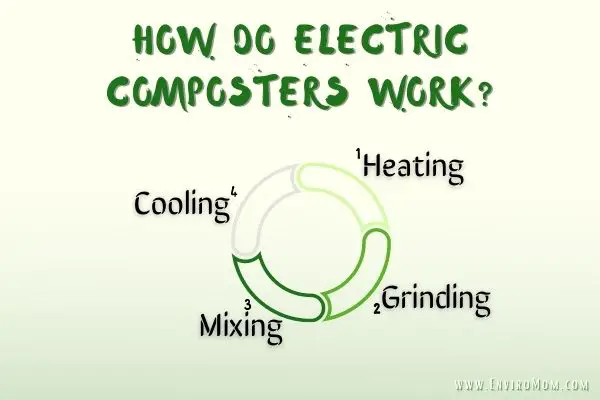
Heating
Heat is an extremely important part of composting as a whole. Electric compost bins would not work without the use of relatively high temperatures!
By heating the material inside to around 160℉, the electric composter kills off germs, contaminants, and viable fruit and vegetable seeds.
In some models, this heat is also responsible for removing the moisture from the kitchen scraps, which makes the final product incredibly lightweight.
Grinding
It’s not enough to just dry out your kitchen scraps. The next step is to physically break down the material into very small pieces.
This step preps the material to continue decomposing once it is added to your potted plants or garden beds. It also makes it easier to evenly distribute.
Electric composters that utilize physical grinding process kitchen scraps significantly faster than those that rely on natural composition alone.
Mixing
Mixing or rotating the organic material ensures that heat and air are able to reach everything inside the machine. This stage ensures that the resultant compost is evenly processed and ready to add to your garden.
Cooling
Cooling is, honestly, the least important part of electric food recycling. This step just ensures that the processed material is cool enough to handle immediately after being broken down.
Are Electric Compost Bins Better Than Traditional Composting?
First time I heard about an electric compost, my reaction was pretty much “why would you need one”?
One of the great things about composting is that you don’t need any technology or power. For me, that is definitely a plus.
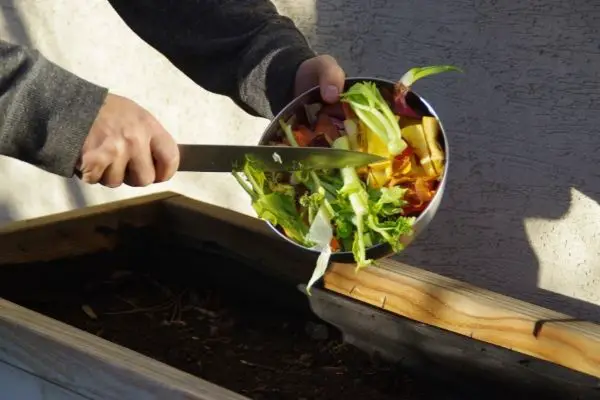
As long as you have organic waste and a place to store it, anyone can create a compost pile in their backyard or take it to a community garden and other shared locations.
Of course, not everyone has outdoor space that can accommodate a compost heap or bin. And I can understand that trips to a garden can take their time. This has led to the growing popularity of kitchen composting machines.
It turns out there are benefits to electric compost!
A kitchen composting machine makes it possible to break down food waste without ever leaving your home. Whether you live in an apartment or just don’t have the time to maintain a regular composting system, electric composters make great alternatives.
It is also super quick. Instead of weeks or months, your food scraps are turned into soil almost instantly!
But it’s also important to note that some electric compost bins do not create the same product as traditional compost.
Traditional compost is full of moisture and beneficial bacteria. Meanwhile, some electric composters produce dry, sterile material.
While traditional compost can be used to replace topsoil, material produced by this style of electric composting may not. Instead, the dry material is exclusively used as an organic fertilizer to amend the soil.
The Best Electric Compost Bins To Get You Started
Because electric composting is such a new concept, there are far fewer options on the market than you might expect.
We’re excited to see what the future holds for electric compost bins! For now, though, here are the best systems to try out yourself:
Vitamix FoodCycler FC-50

The Vitamix FoodCycler FC-50 is an extremely compact alternative to traditional composting that can fit within one square foot of counter space.
You can place all compostable food scraps inside the Vitamix FoodCycler as well as many non-compostable items like meat and dairy. This electric compost bin cannot break down hard materials like avocado pits or nuts and shells. More information about what can be placed in the Vitamix FoodCycler is available here.
The built-in carbon filter keeps odors from infiltrating your kitchen (or wherever else you choose to set up your food recycler).
The Vitamix Foodcycler can take several hours to completely break down the food scraps inside. And because the Vitamix FoodCycler uses intense heat to remove moisture from the scraps inside, the resultant material is not traditional compost.
BeyondGREEN Automatic Organic Waste Composter

Unlike the Vitamix FoodCycler, the BeyondGREEN Organic Waste Composter produces dense, moist compost just like your backyard heap.
The BeyondGREEN Composter can process all compostable items as well as meat, dairy, pet waste, and special bags. Sawdust pellets are used to supplement the household scraps inside in place of “brown” material like dead leaves or cardboard.
This electric composter can be stored indoors or outdoors. It features a built-in filter to keep odors at bay no matter where you choose to keep it.
BeyondGREEN’s automatic composter can process up to 5 pounds of waste per week. It takes approximately 5 to 14 days for fresh material to fully break down into compost.
The machine features separate upper and lower compartments so you can add new material without disrupting the current decomposition process.
Lomi Countertop Composter

While the Lomi Countertop Composter is not yet available (outside of preorders), it’s sure to be an exciting new addition to the electric compost bins you can start using today.
The Lomi Countertop Composter offers three different modes: One for quickly turning food waste into dry, sterile fertilizer. One for breaking down bioplastics. And one for transforming everyday kitchen waste into nutrient-rich compost.
Creating traditional-style compost with this machine takes as little as 20 hours, which is nothing compared to the length of time required to create regular compost outdoors. Despite the short processing time, Lomi claims to preserve the important microbes present in your food waste.
The Lomi Countertop Composter can process compostable food scraps plus meat and dairy. You can also add lawn and garden clippings to the machine for processing.
Is an Electric Compost Bin Right for You?
While electric food recycling is a fun and exciting development in more sustainable waste management, it’s not the end-all-be-all of eco-friendly living.
With that said, here are just a few examples of people who could benefit greatly from investing in one of these kitchen gadgets:
Apartment Dwellers
For those without the outdoor space to start a regular compost heap, an electric composter may be the only viable option. The broken-down material can be used to supplement indoor houseplants or garden containers on your balcony.
Big Families

If your household produces more kitchen waste than you can reasonably compost, an electric composting machine could help keep this organic matter out of the trash. There’s no rule saying that you must choose between traditional composting and an electric food recycler!
Those with Limited Mobility
Not everyone has the physical means to build and maintain a traditional compost pile. An electric compost bin can be filled, maintained, and harvested without needing to leave the house or lift a single garden tool.
Non-Gardeners
Are There Other Ways To Compost Indoors?
Regardless of how great traditional composting is for the environment as a whole, it’s just not possible for everyone to participate. The good news is that an electric compost machine is not the only indoor system available.
We often associate composting with gardeners. But composting is an extremely sustainable practice even for those who don’t partake in this pastime for themselves. A dry electric food recycler can be used to responsibly break down food scraps without creating pounds and pounds of dense compost.
Here are two alternatives to consider before investing in an electric composter of your very own:
Bokashi
Perhaps the most popular form of indoor composting – as well as my personal favorite – is Bokashi composting. This is a Japanese technique that uses fermentation to rapidly break down kitchen scraps.
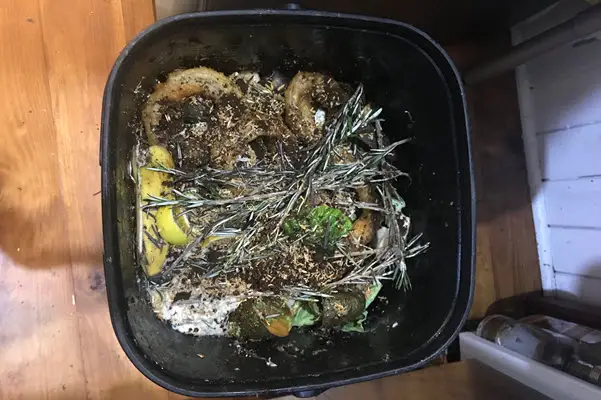
Bokashi composting can be done indoors because the entire process happens in an airtight container. There’s no need to worry about odors (or worse) seeping out of your Bokashi bin and onto your kitchen counter – provided the bucket is tightly sealed.
Like an electric composter, a Bokashi bin can be filled with any and all kitchen scraps. Even meat, dairy, and other non-compostable scraps can be placed in your Bokashi system. (Excessive amounts of already moldy food should NOT be added to Bokashi compost!)
Bokashi compost cannot be added on top of the soil. Instead, it should be added to a traditional compost bin to further decompose or buried in the soil. Keep this extra step in mind if your main interest in composting stems from your garden!
If you are interested in Bokashi, check our guide to the best Bokashi bucket.
Vermiculture
Knowingly bringing worms into your home might not sound like your idea of a good time. But vermiculture — the use of live worms to break down organic material — is actually one of the best ways to compost within your kitchen.
Vermiculture can be performed on a much smaller scale than regular composting. Because vermiculture relies on living worms to aid in decomposition, it also takes far less time for food scraps to fully break down.
The main downside to vermiculture versus an electric food recycler is that you cannot dispose of meat, dairy, and other composting no-nos using this system.
Vermicompost (compost created using a worm bin) can be used as a soil amendment in your garden or potted plants.

A worm bin can be kept in a cupboard, in a closet, or on your kitchen counter. There are even some systems that look like regular decor (while the worms inside are hard at work).
And, no matter how large or small your worm bin operation ends up being, vermiculture requires LESS work and oversight than traditional composting.
Frequently Asked Questions
Is a compost tumbler the same as an electric composter?
No! A compost tumbler is a compost bin that is not connected to any power source. Compost tumblers are typically kept outdoors in place of a traditional compost heap.
A compost tumbler is a convenient alternative to turning a heap or pile by hand. The user can easily rotate the container using a handle or lever to redistribute the material inside. The tumbler does not rotate on its own.
Compost tumblers do not heat or pulverize the organic materials inside. Instead, everything breaks down just as it would in a traditional compost bin.
How often should compost be turned?
Various factors can affect how often compost should be turned. According to The University of Illinois, most compost is turned every 4 to 5 weeks. Generally, compost should not be turned more frequently than every 2 weeks.
More frequent turning can help the compost break down faster. However, it’s important to give the center of the compost enough time to heat up before turning for the best results.
Does indoor composting attract pests?
It can. But whether or not insects and other vermin find your kitchen scraps mostly depends on what type of system you use.
Many traditional composters rely on a small bin to collect food scraps before adding them to the actual compost. These containers are the most likely to attract pests, so be sure to invest in one that is airtight and empty it frequently.
On the other hand, bokashi and electric compost bins are very unlikely to draw in pests. The fermentation process of bokashi composting deters insects and other animals. And, as long as you’re processing food scraps right away, electric food recycling doesn’t give pests enough time to be attracted to your kitchen waste.
Last update on 2024-07-11 / Affiliate links / Images from Amazon Product Advertising API






